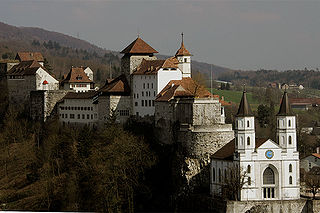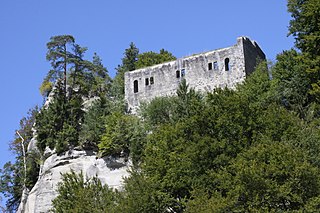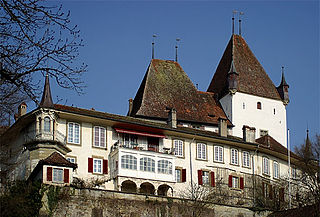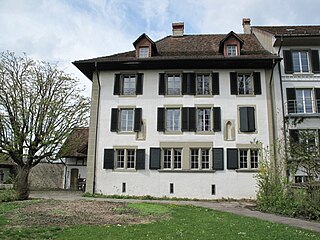
The canton of Bern, or Berne, is one of the 26 cantons forming the Swiss Confederation. Its capital city, Bern, is also the de facto capital of Switzerland. The bear is the heraldic symbol of the canton, displayed on a red-yellow background.

Münchenwiler is a municipality in the Bern-Mittelland administrative district in the canton of Bern in Switzerland.
Payerne Priory was a Cluniac monastery at Payerne, in Vaud, Switzerland. The monastery is a Swiss heritage site of national significance.

The city of Bern is one of the Zähringer foundations of the late 12th century. By the end of the 13th century, it had acquired de facto imperial immediacy. It became a full member of the Old Swiss Confederacy in 1353, and during the 15th century managed to significantly expand its sphere of influence, notably with the conquest of Aargau in 1415. With the acquisition of Vaud in 1536, Bern became the most powerful city-republic north of the Alps, and one of the leading Protestant cities in early modern Switzerland. The canton of Bern in the Restored Confederacy of 1815 even after the loss of Aargau and Vaud remained the largest Swiss canton, relegated to second rank only with the secession of Jura in 1979. Since 1848 Bern has served as the federal city (capital) of Switzerland.

Bulle is a municipality in the district of Gruyère in the canton of Fribourg in Switzerland. In January 2006 Bulle incorporated the formerly independent municipality of La Tour-de-Trême.

Hauterive Abbey is a Cistercian abbey in the Swiss municipality of Hauterive in the canton of Fribourg. It is a Swiss heritage site of national significance. The entire Hauterive area is part of the Inventory of Swiss Heritage Sites.
Switzerland, officially the Swiss Confederation, is a collection of semi-autonomous cantons. As membership of the confederation has fluctuated throughout history, each of these cantons has its own unique history and nobility. Typically, each canton had its own constitution, currency, jurisdiction, habits, customs, history, and nobility.

Aarburg Castle is a castle in the municipality of Aarburg in the canton of Aargau in Switzerland. It is located high above the town Aarburg on a steep, rocky hillside. The castle was built around a medieval castle, which controlled the narrow point on the Aare river and served as the seat of Aarburg Vogt. It is classified as a Swiss heritage site of national significance. Today it houses the Kantonale Jugendheim, for holding and rehabilitating juvenile offenders.

Baillival Castle (Bulle) is a bailiff's castle in the municipality of Bulle of the Canton of Fribourg in Switzerland. It is a Swiss heritage site of national significance.

Amsoldingen Castle is a castle in the municipality of Amsoldingen in the canton of Bern in Switzerland. The castle and associated former collegiate church of St. Mauritius are a Swiss heritage site of national significance.

Münchenwiler Castle or Château de Villars-les-Moines is a castle and former Cluniac priory in the municipality of Münchenwiler of the Canton of Bern in Switzerland. It is a Swiss heritage site of national significance.

Oberhofen Castle is a castle in the municipality of Oberhofen of the Canton of Bern in Switzerland. It is a Swiss heritage site of national significance.

Spiez Castle is a castle in the municipality of Spiez of the Swiss canton of Bern. It is a Swiss heritage site of national significance.

Grasburg Castle is a ruined castle in the municipality of Schwarzenburg of the Canton of Bern in Switzerland. It is the largest castle ruin in the Canton of Bern. It is a Swiss heritage site of national significance.

Wimmis Castle is a castle in the municipality of Wimmis of the Canton of Bern in Switzerland. It is a Swiss heritage site of national significance.

Worb Castle is a castle in the municipality of Worb of the Canton of Bern in Switzerland. It is a Swiss heritage site of national significance.

The Münchenbuchsee Commandery was a medieval commandery of the Knights Hospitaller in the Swiss municipality of Münchenbuchsee in the Canton of Bern.

The ruins of Grünenberg Castle, Schnabelburg Castle and Langenstein Castle are a complex of three interconnected castles on a hill above the municipality of Melchnau in the canton of Bern in Switzerland. The three castles formed the center of power of the Barons of Grünenberg in the Oberaargau region during the High Middle Ages.

Blankenburg Castle is a castle and administrative center in the municipality of Zweisimmen in the canton of Bern in Switzerland.

Brandis Castle is the ruin of a hill fort from the 13th century. It stands in the Swiss municipality of Lützelflüh in the Canton of Bern above the village Lützelflüh on a rocky outcrop. Today, only the ruins and the moat are still visible.



















